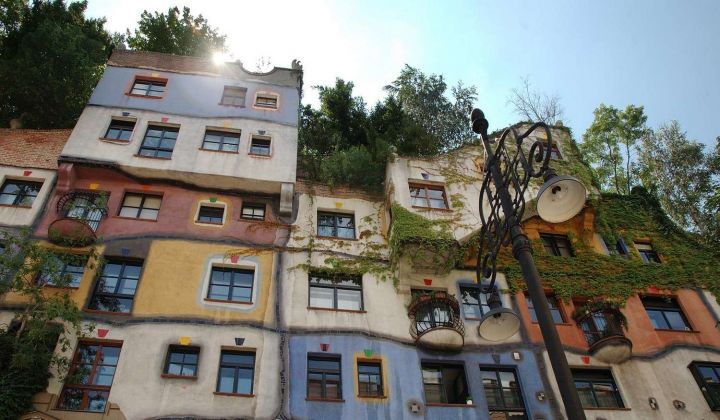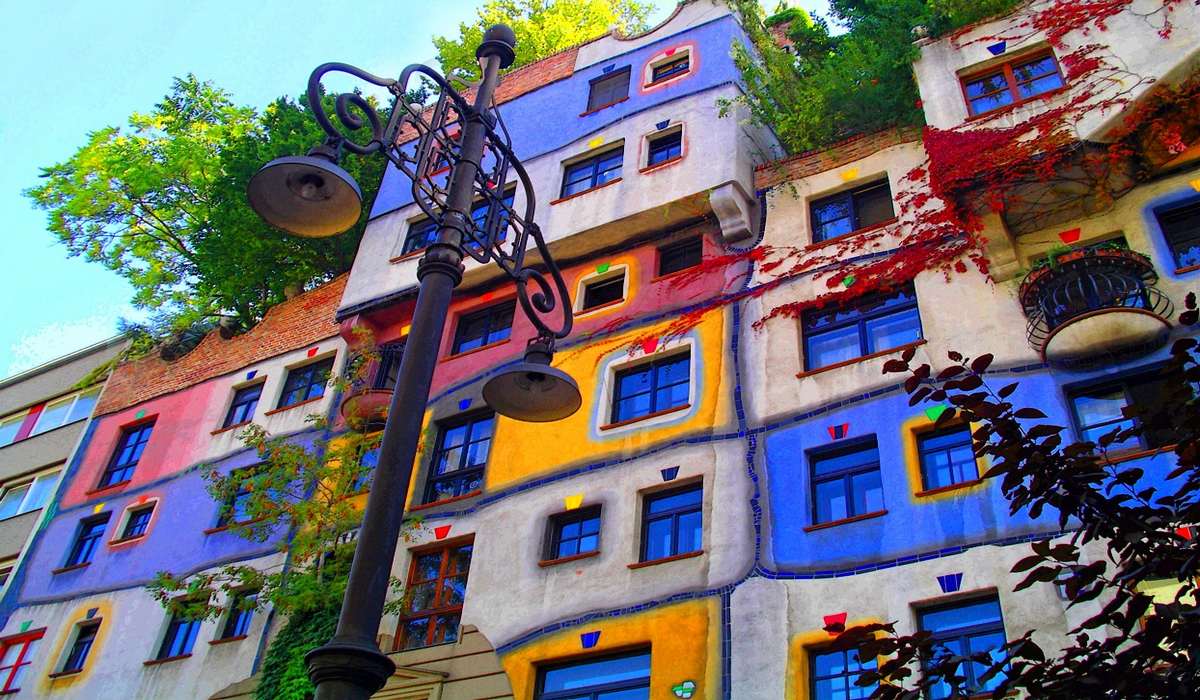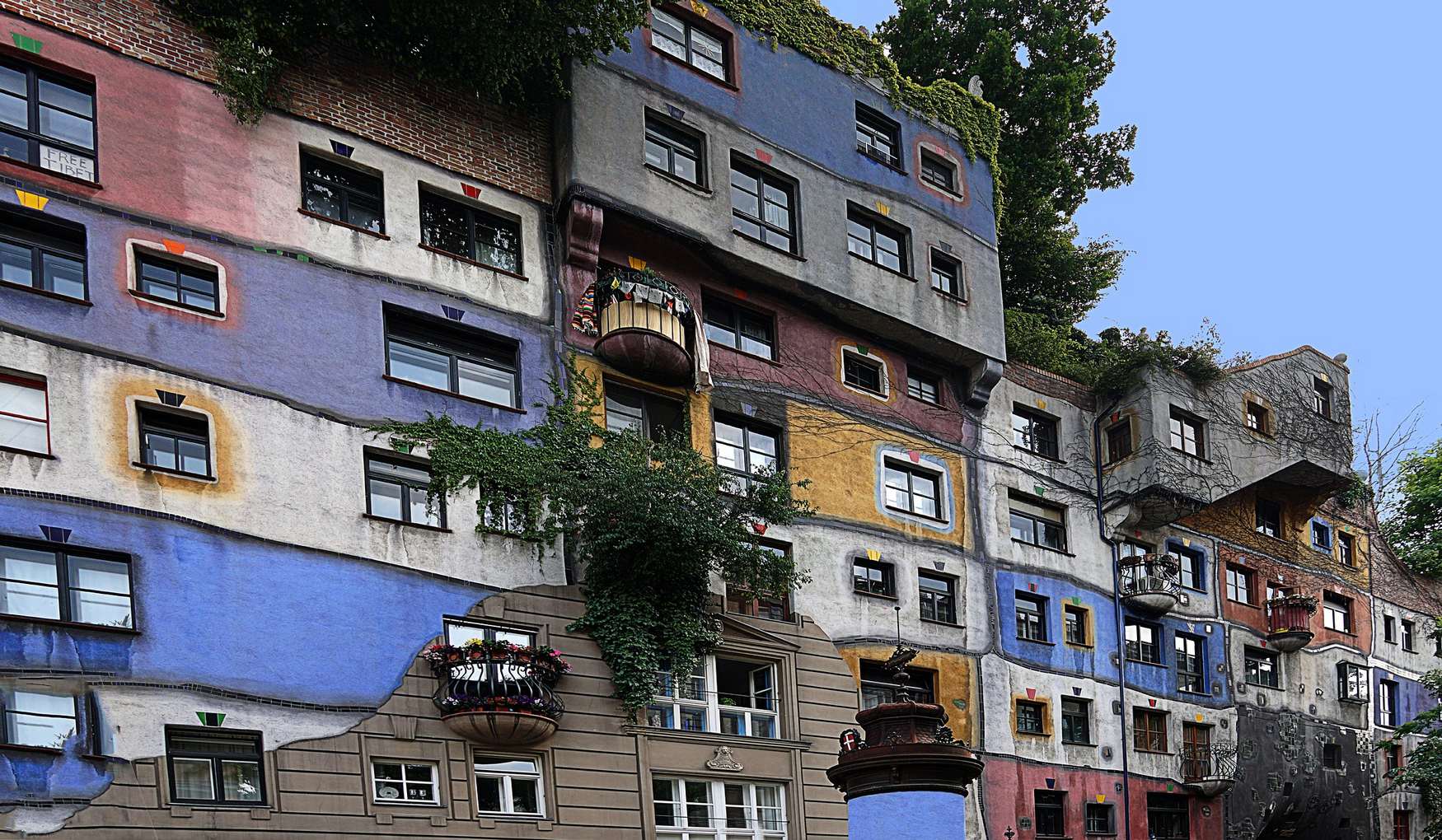A crooked building with windows of different sizes, colourful walls, columns in the most unexpected places, trees growing out of the windows — is it a child's drawing or perhaps something from a magical world? No, this is a real, safe residential building in Vienna, but one that all tourists stop to look at. It's the Hundertwasserhaus — one of Vienna's most unexpected sights. While adults debate whether it is a kitschy building or a bio-technical masterpiece, children fall in love with the colourful house.
Wizard Hundertwasser
Friedrich Stowasser was born in Vienna in 1928. Whether he was known as a child dreamer is unknown, but the adult artist certainly loved games and inventions. He even played with his own name: 'Friedrich' became 'Friedensreich', which means 'rich in peace' in German, and 'Stowasser' became 'Hundertwasser'.
Hundertwasser studied at the Academy of Fine Arts in Vienna, but not for long: his studies had little in common with his creative impulses. So he set up his own art academy, the Pintorarium, and formulated his own vision of painting, architecture and, in particular, the urban landscape. In his view, rationalism in architecture interfered with life, making it dull and monotonous and separating man from nature. He imagined people freely transforming the space around them — at least with a brush and paint.
Hundertwasser himself took on the task of bringing life to dull factory buildings, painting them with patchwork in bright colours, smoothing out sharp corners with a drawing, enlivening grey walls with mosaics, decorating completely flat roofs with domes.
It is reminiscent of the work of the Spanish architect Antonio Gaudi, who also used flowing lines and bright ceramic tiles as decoration.
Hundertwasser also had another idea: that housing should be built into nature. He defined trees as 'tenant trees', trees that grew inside the apartments or at least on the roofs of the houses. The architect saw this as a way of compensating for the damage done to nature by man. Ideally, the houses would grow out of the ground, forming gentle hills. How could you not think of the Hobbit houses in Tolkien's books?
All these ideas are embodied in a multitude of structures based on designs by Hundertwasser. Here are some of the most famous:
- The Kuchlbauer Tower at the brewery in Abensberg, which has even found its way into the city's logo and looks a bit like a waiter with glasses;
- The Spittelau waste incinerator in Vienna, whose mirror-like spheres are not just decoration, but filters that remove heavy metals from the smoke (the heat from the burning waste is used to heat Vienna's apartments);
- The "Waldspirale" in Darmstadt, a residential complex that is as close as possible to the "eco-house" concept, with its flowing façade lines, unique design of each apartment and lots of greenery;
- The Bad Blumau hotel complex — surprisingly dim, pastel and bold, like a child's drawing;
- The Green Citadel in Magdeburg, the architect's latest project, is as striking as any of his other works.
Hundertwasser left instructions for the fate of his creations. He wanted the paint on the houses to age naturally, believing that there is no better artist than nature. However, the master left the residents the right to paint the façade around their windows in any colour they wished. As far as we know, no one has ever exercised this right.
How to view a house
The Hundertwasser House in Vienna is another of the artist's famous creations. Architect Josef Kravina collaborated with Hundertwasser on its design. Although the creators were at odds, a court ruled that Kravina had the right to be considered a collaborator, and since 2010 the building has been officially known as the Hundertwasser-Kravina House.

Construction began in 1983 and was completed in 1986. Since then, the building has lost none of its uniqueness and appeal — it looks like it will be an example of atypical architecture for a long time to come. So what should you look for when you find yourself in front of this remarkable building?
First of all, don't forget to watch your step; cobblestones have replaced asphalt and the pavement overhangs the fountain fence and lifts trees in places.
Once you have found a stable position (some people sit on benches or mounds of cobbles), raise your eyes to the house. It is important to keep your feet on the ground: if you are used to the right angles of modern houses, uneven lines, oddly placed windows and asymmetrically placed balconies can make your eyes swim.
The sight of the building conjures up all sorts of associations.
Children who have seen the Harry Potter films will recognise Nora in the Hundertwasser house, the Weasley family's sloping but cosy house, or the house in Grimmo Square, which is only seen by wizards who are in on the secret.
Even without such comparisons, you can't help but notice how strange the austere part of the façade - grey, with standard windows aligned to the string - looks surrounded by a mottled patchwork, as if the tenants had actually armed themselves with different colours, peered out of the windows and painted as much of the wall as they could get their hands on.
You can then walk around the house, looking for as many inconsistencies as possible (if you take typical residential house designs as an example). Here are some of the striking details that can be seen from the street:
- All kinds of columns, as if they were made of giant pearls of different shapes, sometimes set at an unthinkable angle (there are similar columns in the Green Citadel);
- 13 types of windows (Hundertwasser said that houses should not be made of walls but of windows);
- tiled "uneven joints" between apartments (the artist protested against straight lines, which he considered unnatural);
- the protruding upper floors;
- trees growing on terraces, balconies and the roof (the architect thought they would grow into the flats).
- A slender "skyscraper" with a glass façade, tile fragments on the walls and a dome on the roof, squeezed into the middle of a low, stocky building.
The most observant will notice that the decoration above the windows is the same everywhere, only the colours are different. The decorative elements are not painted, but tiled. The best time to visit Hundertwasser's house in Vienna is spring or summer, when you can see how green it is.
Interiors
Tourists fascinated by the facades of the house would love to get inside and see if the interiors are as amazing as they are. But the Hundertwasser House in Vienna is a residential building and can only be entered by invitation from one of the residents. If you don't have one, you have to believe that the inside of the house is also unusual. The corridors and staircases are as winding as forest paths. The corners of the rooms are rounded and the walls flow seamlessly into the floor as if they were caves. The floors are also sloping, like clearings in a forest. The tiles in the bathrooms and toilets are laid unevenly, as if the pattern were made up of splinters. Despite these eccentric solutions, not a single flat in the house is empty.
In addition to the living quarters, the house has space for several offices, recreational terraces and children's playrooms. The children's rooms have light-coloured tiles and rounded walls, but the decoration is kept to a minimum.
Incidentally, there is a reliable way of distinguishing the apartments from the common areas. The walls of the apartments are painted in bright colours on the outside, while the communal areas are painted grey.
Attractions nearby
You can't go inside the house, but you can still immerse yourself in the imaginative architect's world. Next door to Hundertwasser's house is Vienna's House of Art, or 'Green Museum', which houses the largest collection of Hundertwasser's work. The paintings and tapestries all have the same ideas: flowing lines and spirals, rich colours and a surprisingly harmonious chaos. Other paintings often include images of houses, and there are also sketches for completed projects. The museum building has been rebuilt according to the artist's design and, unlike many other houses, the façade is in black and white.
It is interesting to note that Hundertwasser did not limit himself to painting and architecture. He worked in tapestry, designed stamps and aircraft livery. And in life, the master likes to wander. For example, he never wore matching socks — who would have thought that this would become a fashion trend these days?
Another building in the area is Hundertwasser Village. This, like some of Hundertwasser's other projects, is not a new building. It used to be a garage, first for post coaches, then for cars. The artist rethought the space and the garage became a gallery with several souvenir shops, a café and, you guessed it, a toilet, which is not at all out of place in the overall concept. Asymmetry reigns here too, with columns of different sizes and tiles stacked in fanciful patterns. The courtyard of the gallery is planted with trees. On the walls are reproductions of several paintings by Friedensreich Hundertwasser.
Afterwards, it's worth stepping out onto the Danube promenade to see the familiar columns and colourful tiles again. The smallest of Hundertwasser's buildings is the Danube Shipping Company pavilion.











